Abstract
The main objective of the present study is to analyze the nature and capture the corresponding consequences of the solution obtained for the Gardner–Ostrovsky equation with the help of the -homotopy analysis transform technique (-HATT). In the rotating ocean, the considered equations exemplify strong interacting internal waves. The fractional operator employed in the present study is used in order to illustrate its importance in generalizing the models associated with kernel singular. The fixed-point theorem and the Banach space are considered to present the existence and uniqueness within the frame of the Caputo–Fabrizio (CF) fractional operator. Furthermore, for different fractional orders, the nature has been captured in plots. The realized consequences confirm that the considered procedure is reliable and highly methodical for investigating the consequences related to the nonlinear models of both integer and fractional order.
Keywords:
internal waves in rotating ocean; fractional derivative; q-Homotopy analysis transform technique; fixed point theorem MSC:
34A08; 26A33; 65L05
1. Introduction
The concept of fractional calculus (FC) has received much consideration in recent years due to its wide applicability and ability to capture more consequences of real-world problems. Even though the concept of classical calculus can exemplify most real-life problems and aid us in predicting the nature of complex phenomena, it has become a narrow subset of FC. Even though pioneers propose many new notions, many things need to be derived in order to ensure all classes of phenomena, which will be achieved by overcoming the limitations raised by mathematicians and scientists [1,2,3,4,5,6,7]. This is particularly true when researchers try to study, analyze and predict behaviors related to history, long-range memory, heritage, chaos, epidemiology, and other such subjects. There is always a door open for innovation, novelty, improvisation, and modifications in the research when it comes to the investigation of consequences that help us to solve real-world problems (the present pandemic, for example) and in this connection, many researchers have derived stimulating results with the aid of FC, and by using efficient techniques with the aid of fundamental results of FC [7,8,9,10].
The investigation of physical models and analysis of the associated properties are always a hot topic in applied mathematics with appropriate tools. In particular, this is the case for research on earthquakes, electrochemistry, signal processing, viscoelastic models, fluid dynamics, plasma physics, and many others. In the present investigation, we consider the nonlinear model describing the strong interacting internal waves in the ocean. In 1995, Oregon Bay experimented Coastal Ocean Probe Experiment (COPE) [11], found that the internal shallow waves are very strong, and also, it is stated that the shallow water wave phenomena are not completely nurtured with one nonlinear term. Furthermore, there is a need for dual nonlinear terms to examine the physical behaviors of the model. These experiments on shallow-water waves aid in formulating the model with dual-power law nonlinearity.
The equation that exemplifies the above phenomena is familiarly known as the Gardner equation. Generally, the Korteweg de-Vries (KdV) equations are widely used to exemplify the behaviors of long waves and their physical significance. Here, we consider the modified KdV equation, called the Gardner–Ostrovsky (GO) equation, due to the large amplitude for long internal waves and extended rotational effects [12]. Now, we consider the following two equations respectively exemplifying Ostrovsky and Gardner-Ostrovsky (GO) equations with the isopycnic surface (:
where and are, respectively, quadratic and cubic nonlinearities coefficients, is the coefficient of small-scale dispersion, and is the velocity of dispersion-less linear waves. Here, and are two proportional terms involving in the above equations, and is due to the nonlinear hydrodynamic system, and it comes traditionally. Moreover, the term appears when is a bird that is arbitrarily small. The GO equation is employed, and formally known to exemplify by large-amplitude waves with strong nonlinearity effects [13,14,15,16,17,18].
Recently, many authors illustrated the fractional operator’s essence in capturing and understanding the more relative consequences of physical phenomena with higher nonlinearity and complexity with long-range memory and history-based properties [19]. In this paper, we consider the fractional-order version of Equations (1) and (2) with Caputo–Fabrizio fractional operator with order , fractional Ostrovsky (FO) and fractional Gardner–Ostrovsky (FGO) equations given by:
The vital and challenging job is finding the solution for nonlinear problems. Even though we have distinct schemes for finding the solution for these problems, they may possess a conversion of nonlinear to linear, partial to ordinary, perturbation, assumption of additional parameters, or discretization. Here, we consider the method proposed based on a topological concept called the homotopy analysis technique, which is nurtured to solve complicated nonlinear problems, and for 20 years, numerous scholarly works have been carried out with the aid of this [20,21]. Mankind is always searching for innovation, modernization and improvisation to increase accuracy and reduce the complexity associated with the method. In association with this, the authors in [22] came with the improvisation associated with Laplace transform (LT).
The projected scheme offers more freedom to choose the initial conditions, and the novelty is that it offers a simple solution procedure. This method is perceptible and includes all merits achieved by HAM, and also it attracted many researchers to analyze the diverse class of models and systems. The novelty of the projected scheme is the ability to solve the nonlinear problems without any assumption, perturbation, or conversion from nonlinear to linear, or partial to ordinary differential equations. Moreover, it is associated with parameters that are very helpful in converging the results attained towards a beneficial solution. Furthermore, it is related to well-posed transformation, which aims to reduce the complexity and increase the applicability and reliability of the method.
The considered technique (-HATT) is widely used for examining diverse classes of nonlinear problems and investigating the distinct mathematical models associated with real life [23,24,25,26,27,28,29,30]. For instance, the system of nonlinear differential equations exemplifying the outbreak of COVID-19 in India is examined within the frame of a nonsingular derivative in [24] using the projected scheme; HIV infection of lymphocyte cells is numerically analyzed by researchers in [25]; some interesting results have been derived with the help of the considered algorithm by authors in [29], in which the system exemplified the wind-influenced projectile motion; and the numerical simulation is presented by authors in [28] for the coupled Korteweg-de Vries system and this derived some interesting consequences in terms of numerical simulation.
2. Preliminaries
The basic definitions are presented in this segment for the CF and Laplace transform. Specifically, we recall the notions related to Caputo–Fabrizio fractional operator [19,31].
Definition 1.
The CF fractional derivative foris presented as [19]:
where is a normalization function and admits Further, if then we have:
Definition 2.
The CF fractional integralforis presented as [31]:
Note:
According to [31], the following must hold:
which gives With the help of the above equation, researchers in [31] proposed a novel Caputo derivative as follows
Definition 3.
The LT for a CF derivativeis presented as [19] below:
3. Fundamental Procedure of the Considered Method
Here, we hired the differential equation to present the basic algorithm of the projected method with the initial condition:
and
We obtained this by applying LT on Equation (11):
For , is contracted as follows:
where . Then, the homotopy is defined by results in:
For and , we have:
By using the Taylor theorem, we consider:
where
For the appropriate chaise of ,and the series (15) converges at . Then:
After differentiating Equation (15) -times with and multiplying by and substituting , one can obtain:
where
Equation (20) reduces after employing inverse to:
where
and
Here, is homotopy polynomial and presented as:
By the help of Equations (22) and (23), we found:
With the help of -HATM, the series solution is:
4. Solution for FO and FGO Equations
The above-illustrated scheme is employed for the two fractional-order equations (namely, FO and FGO equations).
Case I.
For FO equation
Consider the equation defined in Equation (3):
with
Taking on Equation (28) and with the help of Equation (29), we obtain:
Now, is defined as:
At , the deformation equation presented as:
where
On employing inverse on Equation (32), it simplifies to:
Now, by simplifying the above system we can evaluate the terms of the series solution:
Now, by the help of the initial condition, we can derive the terms of Equation (29) as:
4.1. Existence of Solution for Ostrovsky Equation
Here, the existence and uniqueness are illustrated with CF operator for the considered Equation (28) as:
Now, using Equation (36) and results derived in [31], we obtained:
Then we have from [31] the follows:
Theorem 1.
The kerneladmits the Lipschitz condition and contraction if satisfies.
Proof.
Consider the two functions A and to prove the theorem, then
where and are the bounded function and is also a bounded function. Set in Equation (39), then:
Equation (40) provides the Lipschitz condition for . Similarly, we can see that if , then it implies the contraction. With the help of the above equations, Equation (38) simplifies to:
Now, between the terms the successive difference is defined as:
Notice that:
Then we have:
Application of the triangular inequality, Equation (45) reduces to:
The Lipschitz condition satisfied by the kernel , then:
□
By the aid of the above result, we state the following result:
Theorem 2.
If we have specific, then the solution for Equation (28) will exist and be unique. Further, we have:
Proof.
Let be the bounded functions admitting the Lipschitz condition. Then, we obtain, using Equations (46) and (47):
Therefore, for the obtained solution, continuity and existence are verified. Now, to prove the Equation (48) is a solution for Equation (28), we consider:
Let us consider:
This process gives:
Similarly, at we can obtain:
Next, for the solution of the projected model, we prove its uniqueness. Suppose is another solution, then:
Now, employing the norm on the above equation, we obtain:
On simplification, this becomes:
From the above condition, it is clear that , if:
Hence, Equation (55) proves our required result. □
Case II.
For the FGO equation
Consider the equation defined in Equation (4):
with condition defined in Equation (29). Now, taking on Equation (56) and by the assist of Equation (29), we obtain:
Now, is defined as:
Here:
4.2. Existence of Solution for Fractional Gardner’s Ostrovsky Equation
Here, the existence and uniqueness are illustrated with CF operator for the considered Equation (56) as:
Now, using Equation (56) and results derived in [31], we obtained:
Then, we have from [31] the following:
4.3. Existence of Solution for the Fractional Gardner–Ostrovsky Equation
Here, we will state the following results in a similar manner carried out for the above case.
Theorem 3.
The kerneladmits the Lipschitz condition and contraction ifsatisfies for Equation (56).
Proof.
Consider the two functions A and to prove the theorem, then:
where and is the bounded function. Set in Equation (63), then:
Equation (64) provides the Lipschitz condition for . Similarly, we can see that if , then it implies the contraction. By the assist of the above equation, Equation (62) simplifies to
Then we obtain the recursive form as follows:
Now, between the terms, the successive difference is defined as:
Notice that:
Then, we have:
Application of the triangular inequality, Equation (69) reduces to:
The Lipschitz condition satisfied by the kernel , then:
□
By the aid of the above result, we state the following result:
Theorem 4.
If we have specific, then the solution for Equation (56) will exist and be unique. Further, we have:
Proof.
Let be the bounded functions admitting the Lipschitz condition. Then, from Equations (70) and (71), we obtain:
Therefore, for the obtained solution, continuity and existence are verified. Now, to prove that Equation (72) is a solution for Equation (56), we consider:
Let us consider:
This process gives:
Similarly, at we can obtain:
Next, for the solution of the projected model, we prove the uniqueness. Suppose is another solution, then:
Now, employing the norm on the above equation we obtain:
On simplification:
From the above condition, it is clear that , if
Hence, Equation (79) proves our required result. □
5. Results and Discussion
Here, we capture the physical nature of two cases with different fractional order, small-scale dispersion, and homotopy parameters. It is essential to illustrate the effect of the fractional operator incorporated in the considered model. For Case I, we present the surfaces of fractional values of the order in Figure 1, and then it is illustrated in Figure 2 with a particular value of time . In the Ostrovsky equation, the dispersion term plays a pivotal role and its effect is presented in Figure 3 with attained results. The main advantage of the considered scheme is the association of homotopy parameters (n and ). They play a critical role in the archiving solution for the modulation of convergence. For Case I we presented -curves in Figure 4.
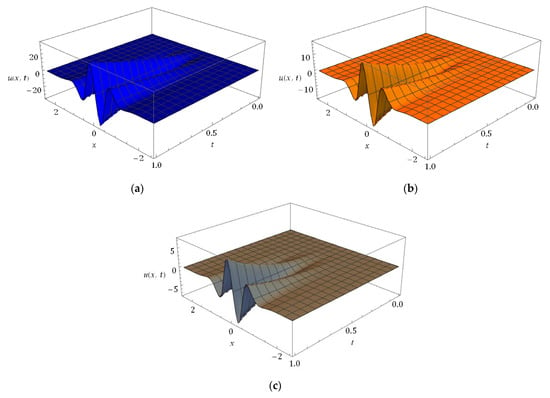
Figure 1.
Surfaces of -HATT solution for (a) , (b) and (c) at and for Case I.
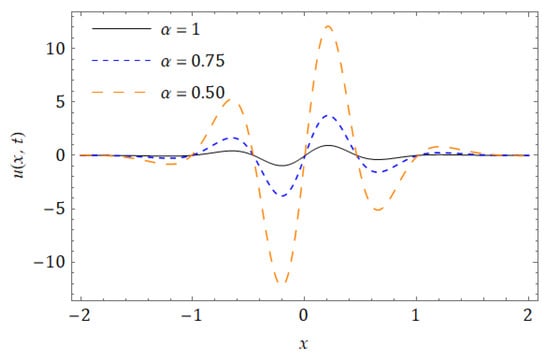
Figure 2.
Response of the obtained solution with distinct and time at and for Case I.
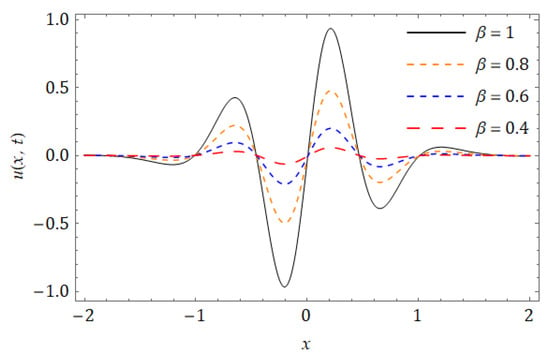
Figure 3.
Response of the obtained solution with distinct and time at and for Case I.
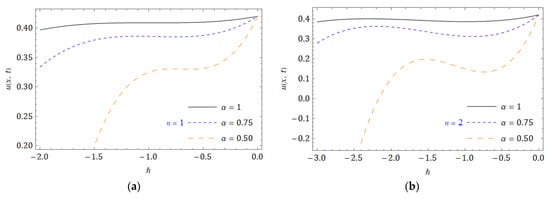
Figure 4.
-curves for Case I at and for (a) and (b) .
Similarly, we present Case II (i.e., fractional Gardner–Ostrovsky equation). For the change in fractional values of the order, we capture the response in Figure 5 and Figure 6. The effect of the small dispersion term in the FGO equation is cited in Figure 7. In Figure 2, we have a diverse change in between the range of and with . With the change in within the range of and 1 for this case, we can observe peak variations with the same values that we observe for with fractional order in Figure 3, and similarly for Case II in Figure 6 and Figure 7. For Case I and II, we respectively presented -curves in Figure 8.These types of studies can influence researchers to investigate physical phenomena.

Figure 5.
Surfaces of -HATT solution for (a) , (b) and (c) at and for Case II.
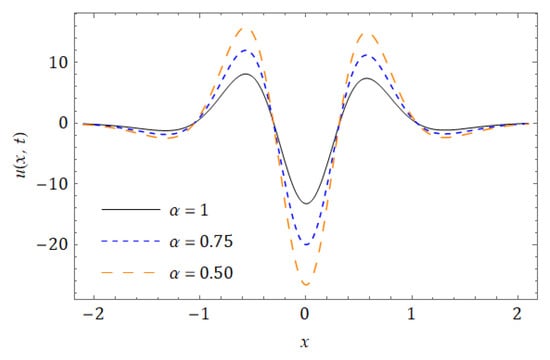
Figure 6.
Response of the obtained solution with distinct and time at and for Case II.

Figure 7.
Response of the obtained solution with distinct and time at and for Case II.
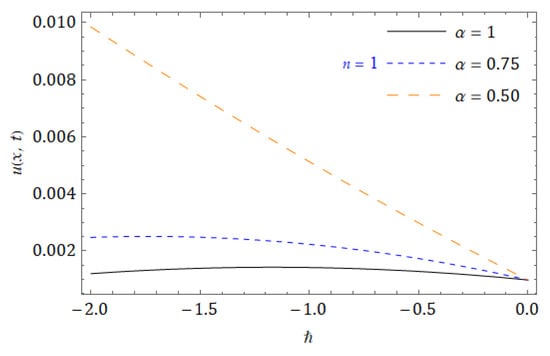
Figure 8.
Curves for Case II at and .
6. Conclusions
In this study, we investigated the equations exemplifying the rotating ocean with strong interacting internal waves with the fractional operator using -HATT. With the help of the fixed-point hypothesis, the existence of the solution of the two cases is illustrated associated with the Caputo–Fabrizio operator. Furthermore, the effect of the coefficients of small-scale dispersion is illustrated with change in space for both the cases, and we found noticeable variations in the archived results. The considered scheme is free from many limitations, including conversion from PDE to ODE, nonlinear to linear, or discretization. Finally, the present study demonstrates the effect of fractional order, parameters associated with models, and methods with their corresponding consequences.
Author Contributions
Conceptualization, methodology, software, writing: P.V.; validation, formal analysis: H.M.B.; investigation, resources: W.G. All authors have read and agreed to the published version of the manuscript.
Funding
This research received no external funding.
Institutional Review Board Statement
Not applicable.
Informed Consent Statement
Not applicable.
Data Availability Statement
Not applicable.
Acknowledgments
This projected work was partially (not financial) supported by the Scientific Research Project Fund of Harran University with the project number HUBAP:21132.
Conflicts of Interest
The authors declare no conflict of interest.
References
- Liouville, J. Memoire surquelques questions de geometrieet de mecanique, et sur un nouveau genre de calcul pour resoudreces questions. J. Ec. Polytech. 1832, 13, 1–69. [Google Scholar]
- Riemann, G.F.B. Versuch Einer Allgemeinen Auffassung der Integration und Differentiation, Gesammelte Mathematische Werke; Leipzig, Germany, 1896. [Google Scholar]
- Caputo, M. Elasticita e Dissipazione; Zanichelli: Bologna, Italy, 1969. [Google Scholar]
- Miller, K.S.; Ross, B. An Introduction to Fractional Calculus and Fractional Differential Equations; A Wiley: New York, NY, USA, 1993. [Google Scholar]
- Podlubny, I. Fractional Differential Equations; Academic Press: New York, NY, USA, 1999. [Google Scholar]
- Kilbas, A.A.; Srivastava, H.M.; Trujillo, J.J. Theory and Applications of Fractional Differential Equations; Elsevier: Amsterdam, The Netherlands, 2006. [Google Scholar]
- Baleanu, D.; Guvenc, Z.B.; Tenreiro Machado, J.A. New Trends in Nanotechnology and Fractional Calculus Applications; Springer: Dordrecht, The Netherlands; Heidelberg, Germany; London, UK; New York, NY, USA, 2010. [Google Scholar]
- Baishya, C.; Achar, S.J.; Veeresha, P.; Prakasha, D.G. Dynamics of a fractional epidemiological model with disease infection in both the populations. Chaos 2021, 31. [Google Scholar] [CrossRef]
- Akinyemi, L.; Veeresha, P.; Senol, M. Numerical solutions for coupled nonlinear schrodinger-Korteweg-de Vries and Maccari’s systems of equations. Mod. Phys. Lett. B 2021. [Google Scholar] [CrossRef]
- Baishya, C.; Jaipala. Numerical solution of fractional predator-prey model by trapezoidal based homotopy perturbation method. Int. J. Math. Arch. 2018, 9, 252–259. [Google Scholar]
- Antonova, M.; Biswas, A. Adiabatic parameter dynamics of perturbed solitary waves. Commun. Nonlinear Sci. Numer. Simul. 2009, 14, 734–748. [Google Scholar] [CrossRef]
- Holloway, P.; Pelinovsky, E.; Talipova, T. A generalised Korteweg-de Vries model of internal tide transformation in the coastal zone. J. Geophys. 1999, 104, 333–350. [Google Scholar] [CrossRef]
- Wazwaz, A.M. The variational iteration method for solving linear and nonlinear ODEs and scientific models with variable coefficients. Cent. Eur. J. Eng. 2014, 4, 64–71. [Google Scholar] [CrossRef]
- Apel, J.; Ostrovsky, L.A.; Stepanyants, Y.A.; Lynch, J.F. Internal solitons in the ocean and their effect on underwater sound. J. Acoust. Soc. Am. 2007, 121, 695–722. [Google Scholar] [CrossRef]
- Ostrovsky, L.A.; Pelinovsky, E.N.; Shrira, V.I.; Stepanyants, Y.A. Beyond the KDV: Post-explosion development. Chaos 2015, 25, 097620. [Google Scholar] [CrossRef]
- Biswas, A.; Krishnan, E.V. Exact solutions for Ostrovsky equation. Indian J. Phys. 2011, 85, 1513–1521. [Google Scholar] [CrossRef]
- Grimshaw, R.; Stepanyants, Y.; Alias, A. Formation of wave packets in the Ostrovsky equation for both normal and anomalous dispersion. Proc. R. Soc. A 2015, 472. [Google Scholar] [CrossRef]
- Stepanyants, Y.A. Nonlinear Waves in a rotating ocean the Ostrovsky equation and its generalizations and Applications. Atmos. Ocean. Phys. 2020, 56, 16–32. [Google Scholar] [CrossRef]
- Caputo, M.; Fabrizio, M. A new definition of fractional derivative without singular kernel. Prog. Fract. Differ. Appl. 2015, 1, 73–85. [Google Scholar]
- Liao, S.J. Homotopy analysis method and its applications in mathematics. J. Basic Sci. Eng. 1997, 5, 111–125. [Google Scholar]
- Liao, S.J. Homotopy analysis method: A new analytic method for nonlinear problems. Appl. Math. Mech. 1998, 19, 957–962. [Google Scholar]
- Singh, J.; Kumar, D.; Swroop, R. Numerical solution of time- and space-fractional coupled Burgers’ equations via homotopy algorithm. Alex. Eng. J. 2016, 55, 1753–1763. [Google Scholar] [CrossRef]
- Srivastava, H.M.; Kumar, D.; Singh, J. An efficient analytical technique for fractional model of vibration equation. Appl. Math. Model. 2017, 45, 192–204. [Google Scholar] [CrossRef]
- Safare, K.M.; Betageri, V.S.; Prakasha, D.G.; Veeresha, P.; Kumar, S. A mathematical analysis of ongoing outbreak COVID-19 in India through nonsingular derivative. Numer. Methods Partial Differ. Equ. 2021, 37, 1282–1298. [Google Scholar] [CrossRef]
- Bulut, H.; Kumar, D.; Singh, J.; Swroop, R.; Baskonus, H.M. Analytic study for a fractional model of HIV infection of CD4+T lymphocyte cells. Math. Nat. Sci. 2018, 2, 33–43. [Google Scholar] [CrossRef]
- Prakasha, D.G.; Malagi, N.S.; Veeresha, P.; Prasannakumara, B.C. An efficient computational technique for time-fractional Kaup-Kupershmidt equation. Numer. Methods Partial Differ. Equ. 2021, 37, 1299–1316. [Google Scholar] [CrossRef]
- Kumar, D.; Agarwal, R.P.; Singh, J. A modified numerical scheme and convergence analysis for fractional model of Lienard’s equation. J. Comput. Appl. Math. 2018, 399, 405–413. [Google Scholar] [CrossRef]
- Akinyemi, L.; Huseen, S.N. A powerful approach to study the new modified coupled Korteweg-de Vries system. Math. Comput. Simul. 2021, 177, 556–567. [Google Scholar] [CrossRef]
- Veeresha, P.; Ilhan, E.; Baskonus, H.M. Fractional approach for analysis of the model describing wind-influenced projectile motion. Phys. Scr. 2021, 96, 075209. [Google Scholar] [CrossRef]
- Akinyemi, L.; Şenol, M.; Huseen, S.N. Modified homotopy methods for generalized fractional perturbed Zakharov–Kuznetsov equation in dusty plasma. Adv. Differ. Equ. 2021, 45. [Google Scholar] [CrossRef]
- Losada, J.; Nieto, J.J. Properties of the new fractional derivative without singular Kernel. Prog. Fract. Differ. Appl. 2015, 1, 87–92. [Google Scholar]
Publisher’s Note: MDPI stays neutral with regard to jurisdictional claims in published maps and institutional affiliations. |
© 2021 by the authors. Licensee MDPI, Basel, Switzerland. This article is an open access article distributed under the terms and conditions of the Creative Commons Attribution (CC BY) license (https://creativecommons.org/licenses/by/4.0/).